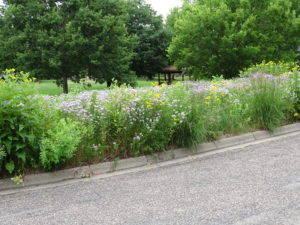Redefining “weeds”
Spring is here!
With new plants sprouting out of the ground, we get antsy to start our spring work. The outdoors calls us to soak up the sunshine, search for spring wildflowers, listen to birds, and prepare our garden beds. Some of that preparation includes removing weeds.
What is a weed, anyway?
Simply, it is a wild plant growing where it is not wanted in competition with cultivated plants. So, it all depends on what you want. If you want plants that stay put, your definition of weed will include more plants.
If you want to provide food and shelter for pollinators and animals, your definition may include fewer plants.
Often, restorations and shoreline plantings look “weedy” because the plants do not stay in orderly rows, giving the garden a messy look. But, the gardener’s desire for habitat allows them more flexibility in the look of their garden. Even the ever-present dandelion can be attractive, when you know how necessary it is for hungry spring bees.
So what?
If you see a garden that looks weedy, see if you can’t identify a plant or two. Look up what uses that plant has, and what role it plays for animals, and you might not be so quick to rail against that gardener. Learning the names of a few “weedy” plants can help you understand what role they play in the ecosystem. You might even be able to relax your own weeding a bit this spring.
